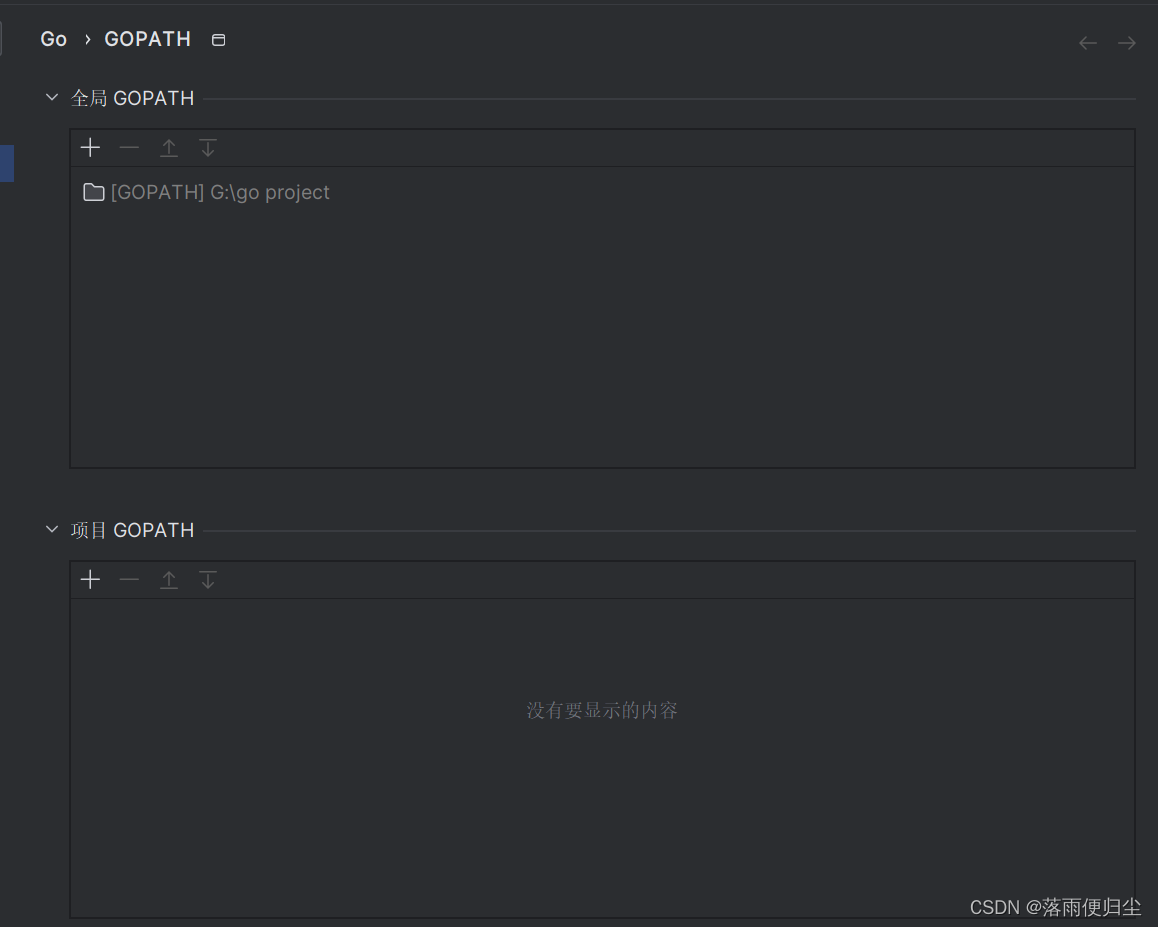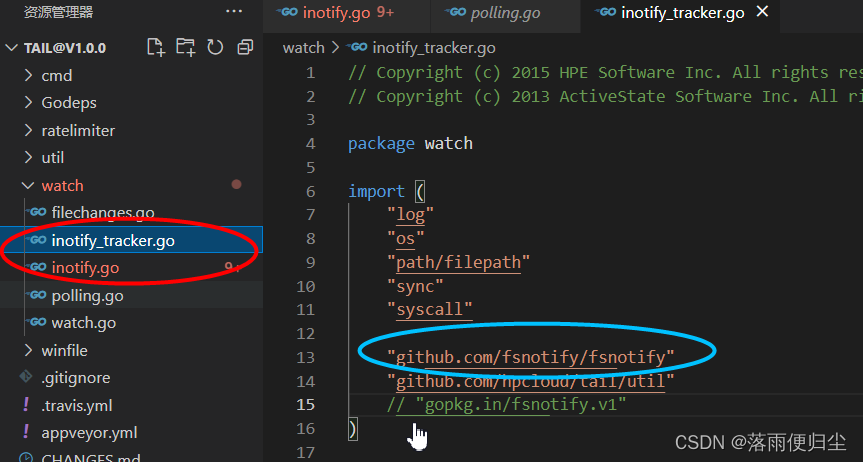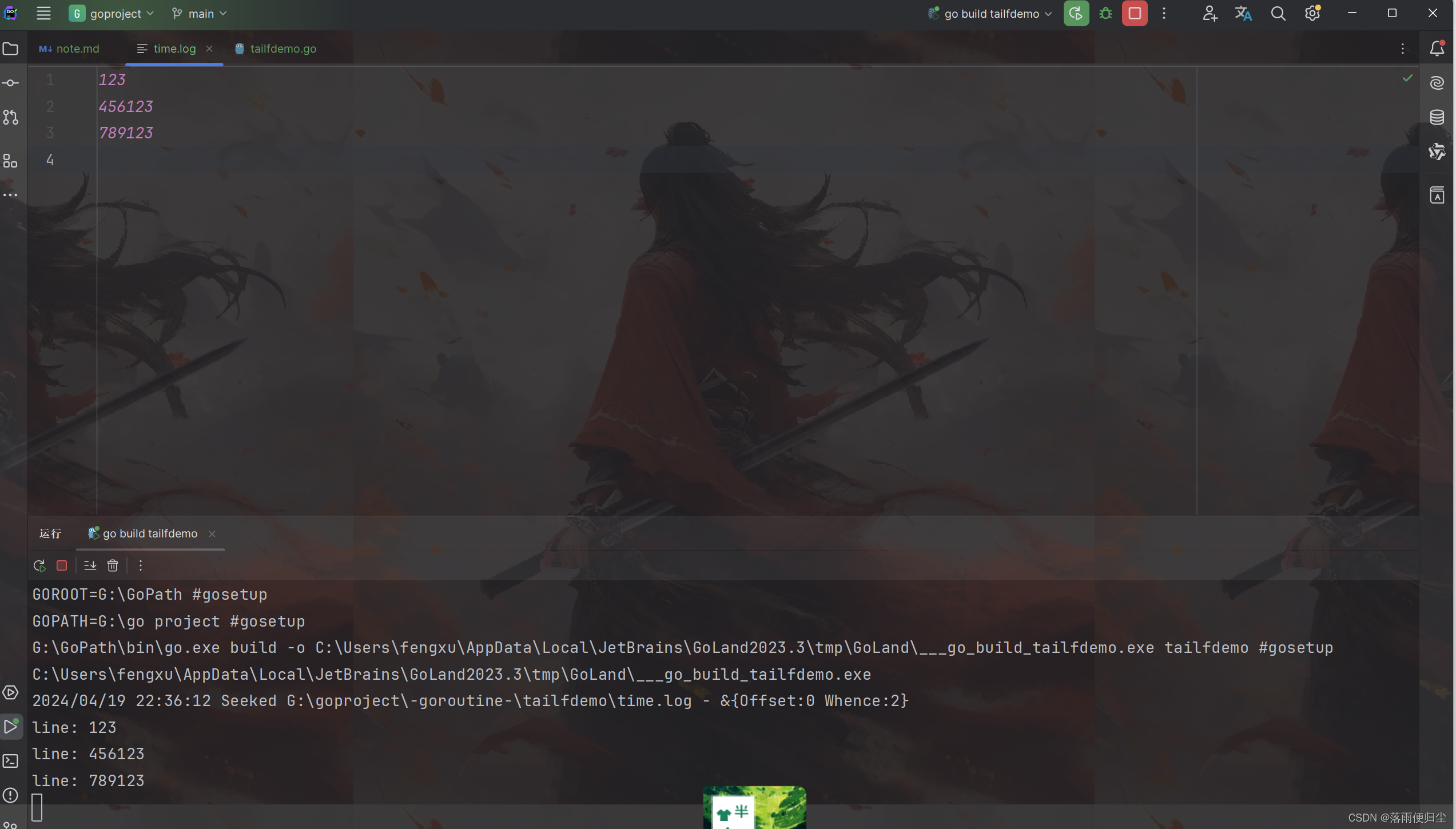Linux中的tail命令
tail 命令是一个在 Unix/Linux 操作系统上用来显示文件末尾内容的命令。它可以显示文件的最后几行内容,默认情况下显示文件的最后 10 行。tail 命令
非常有用,特别是在我们查看日志文件或者监视文件变化时。
基本用法如下:
tail [选项]… [文件]…
一些常用的选项包括:
- -n <行数>:显示指定行数的末尾内容。例如,tail -n 20 filename 将显示文件 filename 的最后 20 行。
- -f:在文件末尾持续输出内容,常用于查看日志文件实时变化。使用 Ctrl + C 终止。
- -c <字节数>:显示指定字节数的末尾内容。例如,tail -c 100 filename 将显示文件 filename 的最后 100 个字节。
tail包简介
go语言中tail包用于输出文件的最后几行。假设该档案有更新,tail会自己主动刷新,确保我们看到是最新的档案内容 ,在日志收集中可以实时的监测日志的变
化。
下载tail包
tail包的地址为:
github.com/hpcloud/tail
但是这里直接执行的话会报错
PS G:\goproject\-goroutine-\tailfdemo> go get github.com/hpcloud/tail go: gopkg.in/fsnotify.v1@v1.4.9: go.mod has non-....v1 module path "github.com/fsnotify/fsnotify" at revision v1.4.9,
这个主要是因为tail包中有依赖包的名字修改了,所以我们也要做对应的修改:
-
首先,打开设置,找到自己的GoPath路径:

-
然后到路径下找到tail包:

-
最后对tail代码目录下的inotify.go和inotify_tracker.go两个文件,
将gopkg.in/fsnotify/fsnotify.v1 修改为 github.com/fsnotify/fsnotify, 然后再执行go mod tidy 命令即可。

- 加载成功:

tail包相关函数及结构体
TailFile函数
func TailFile(filename string, config Config) (*Tail, error) {
}
tail2.TailFile()函数的参数是文件路径和配置文件,会生成一个Tail结构体。在Tail结构体中,最重要的属性是文件名Filename和用于存储文件一行Line
的通道Lines:
type Tail struct {
Filename string
Lines chan *Line
Configfile *os.File
reader *bufio.Readerwatcher watch.FileWatcher
changes *watch.FileChangestomb.Tomb // provides: Done, Kill, Dyinglk sync.Mutex
}type Line struct{ //用来存储每一行日志Text stringTime time.TimeErr error
}
除此之外,还有一个结构体Config用来配置tail2.TailFile()函数的参数:
type Config struct {
// File-specifc
Location *SeekInfo // Seek to this location before tailing
ReOpen bool // Reopen recreated files (tail -F)
MustExist bool // Fail early if the file does not exist
Poll bool // Poll for file changes instead of using inotify
Pipe bool // Is a named pipe (mkfifo)
RateLimiter *ratelimiter.LeakyBucket// Generic IO
Follow bool // Continue looking for new lines (tail -f)
MaxLineSize int // If non-zero, split longer lines into multiple lines// Logger, when nil, is set to tail.DefaultLogger
// To disable logging: set field to tail.DiscardingLogger
Logger logger
}
下面是对一些参数的说明:
-
Location *SeekInfo: 指定文件的起始读取位置。SeekInfo 是一个指针类型,可能包含文件偏移等信息。
-
ReOpen bool: 是否重新打开已经被重新创建的文件。当文件被重新创建时(比如通过 tail -F 命令监视日志文件时),如果设置为 true,则重新打开该文件,继续读取新内容。
-
MustExist bool: 如果文件不存在是否立即报错。当设置为 true 时,如果文件不存在,则会立即报错而不是等待文件出现。
-
Poll bool: 是否使用轮询的方式检查文件变化,而不是使用 inotify。在一些系统上,inotify 可能不可用或者不够稳定,此时可以通过设置为 true 来强制使用轮询方式。
-
Pipe bool: 是否为命名管道(mkfifo)。如果文件是通过 mkfifo 命令创建的命名管道,则设置为 true。
-
RateLimiter *ratelimiter.LeakyBucket: 速率限制器,用于限制文件读取的速率。ratelimiter.LeakyBucket 可能是一个实现了漏桶算法的速率限制器,用于控制读取速度。
-
Follow bool: 是否继续监视文件的新内容(类似于 tail -f 命令)。如果设置为 true,则会持续监视文件,并读取新的行内容。
-
MaxLineSize int: 如果非零,表示最大的行长度。如果读取到的行长度超过该值,则会将其分割成多个行。
-
Logger logger: 日志记录器,用于记录文件读取过程中的日志信息。如果设置为 nil,则会使用默认的日志记录器(tail.DefaultLogger)。如果想禁用日志记录,则可以将该字段设置为 tail.DiscardingLogger。
tail读取日志文件的代码样例;
- 代码
package mainimport ("fmt""github.com/hpcloud/tail""time"
)func main() {filename := "G:\\goproject\\-goroutine-\\tailfdemo\\time.log"config := tail.Config{Follow: true, //进行跟随ReOpen: true, //重新打开MustExist: false, //文件打开失败不报错Poll: true,Location: &tail.SeekInfo{Offset: 0, Whence: 2},}tail, err := tail.TailFile(filename, config)if err != nil {fmt.Println("tail file failed,err:", err)return}for {line, ok := <-tail.Linesif !ok {fmt.Println("tail file close reopen, filename: ", tail.Filename)time.Sleep(1 * time.Second)continue}fmt.Println("line:", line.Text)}
}
这里我们输入log文件中,输出控制台就会实时更新了:

总结
- 流程:
- 首先定义Config结构体,初始化配置文件
- 利用TailFile函数得到Tail结构体,Tail结构体中的Lines封装了拿到的信息
- 循环遍历Tail.Lines,取出信息,可以实现实时监控





字符驱动)



)
性能监控平台搭建JMeter+Grafana+Influxdb)








